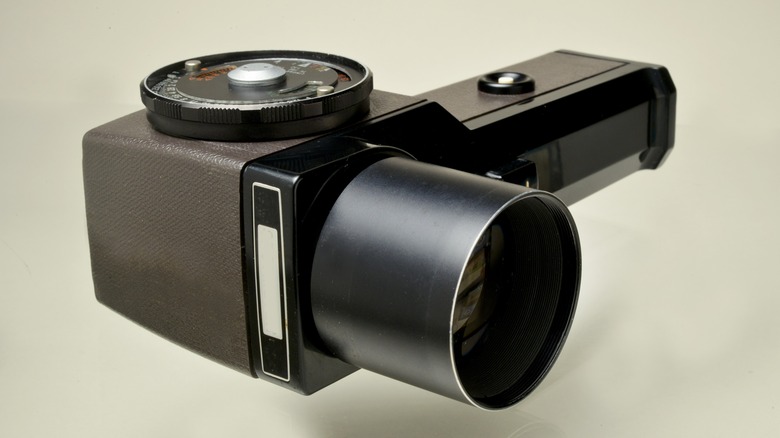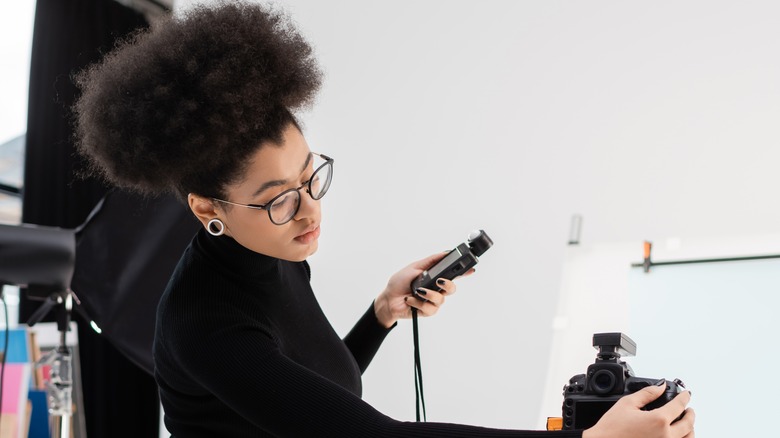The Three Different Types Of Light Meter For Film Photography Explained
Gauging the amount of light that's in a scene is one of the most fundamental and important skills for a photographer to have. Knowing how to set the exposure on a camera will produce a picture that's neither underexposed nor overexposed. Light meters are a godsend for photographers, as they tell them how much light is either falling onto the subject of the shot or reflecting back at the camera. Having that information helps determine the best shutter speed, aperture, and ISO settings to use.
A light meter is one of the many hidden features on a modern DSLR, making the photographer's job significantly easier when setting the camera's exposure. Even some older film cameras have built-in light meters, but a handheld meter is ideal for the most accurate results. While there are only two types of light to measure (incident and reflective), there are three types of meters a photographer can use: incident, spot, and in-camera reflective.
Light meters are most beneficial for those using an analog camera over a digital one because they lack a screen that can show exposure results on demand. Film doesn't allow as much trial and error on the fly since it has to be developed in a dark room long after the photoshoot has taken place. For those budding photographers who love their film or just want more accurate results with their DSLRs, here are the three different light meters you will want to familiarize yourself with.
Incident meter
An incident meter is ideal when photographing people or snapping some close-up shots of a subject. An incident meter measures the intensity of light falling on the subject of a photo to help render accurate color, tonality, and contrast. It's an easy enough task: Simply place the meter in front of the subject with the lumisphere (the white bulb) aimed at the camera. Be sure to hold the meter as close to the subject as possible. There are two methods for incident metering, however.
The lumisphere on incident meters can be positioned in or out, with the out position giving an accurate reading. However, some photographers like to keep the lumisphere tucked in as a means to get a reading that results in overexposure. This is a perfectly valid technique as it's a style choice. As long as the photographer is consistent with how they use the meter throughout a photoshoot it will give solid results. If they're not consistent, it will produce imbalanced photos.
Incident meters are extremely popular, especially with photographers who specialize in street photography, because they give a fast reading. It's as simple as holding the meter next to the subject and reading the light measurement.
Spot meter
Unlike an incident meter that measures the amount of light falling on the subject of a photo, spot meters measure reflective light, the light bouncing off the subject and back at the camera. Also unlike an incident meter, a spot meter isn't held next to the subject. Instead, the photographer or their assistant aims it at the spot they want to measure like it's a scope. This is ideal for photographers taking pictures of a landscape, such as one of the many breathtaking destinations every photographer needs to visit, or a subject that's far away.
A spot meter can also help photographers capture images using the Zone System – a technique in photography popularized by Ansel Adams – measuring shadows, midtones, and highlights independently to nail down the exposure they want for their photos. To find the best exposure settings for their cameras when using reflective metering, photographers will take multiple readings of shadows and highlights. However, reflective metering measurements are affected by different aspects of a shot, such as surface textures, background brightness, and even the shape of the subject.
In-Camera reflective meter
Many modern cameras come equipped with a light meter built inside that will measure the reflective light coming from the photographer's subject. It's similar to a spot meter, measuring the same kind of light. If a photographer doesn't have a spot meter and prefers not to use an incident meter, then the built-in meter is a great tool. However, it's not as accurate as a handheld meter. It will do great in the absence of bright highlights and dark shadows, when the contrast isn't too dramatic.
Some built-in meters can be inaccurate. It's best to have another handheld meter to use alongside, especially if it's your first time using the built-in meter. This will give you an idea of just how imprecise it is, if at all.
Honorary mention goes to the different light meter apps available for smartphones that some photographers might consider as an essential app. There's a surplus of mobile apps on the market that can fulfill your light metering needs. Their accuracy comes down to the developer and the smartphone you use, but some produce favorable results and help cut down on the amount of equipment you lug around.



